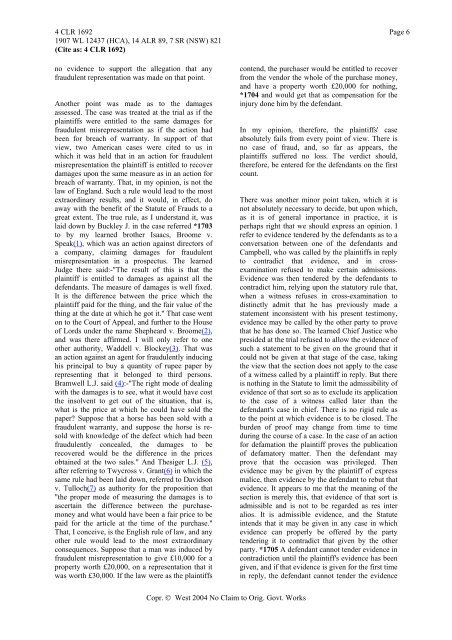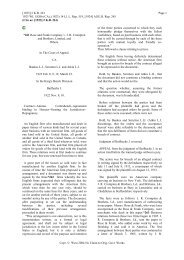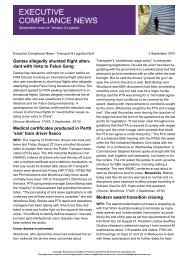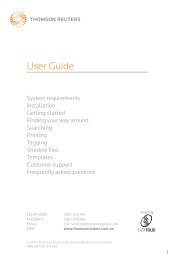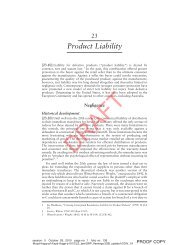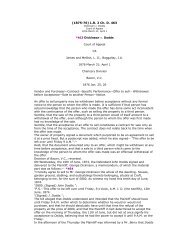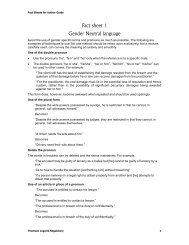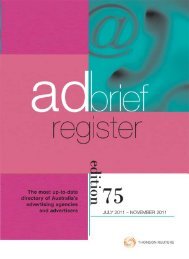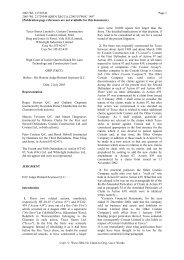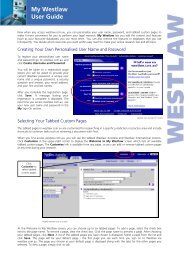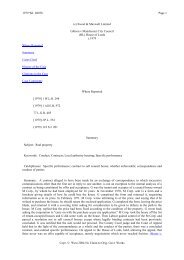Holmes v Jones - Thomson Reuters
Holmes v Jones - Thomson Reuters
Holmes v Jones - Thomson Reuters
- No tags were found...
Create successful ePaper yourself
Turn your PDF publications into a flip-book with our unique Google optimized e-Paper software.
4 CLR 1692 Page 61907 WL 12437 (HCA), 14 ALR 89, 7 SR (NSW) 821(Cite as: 4 CLR 1692)no evidence to support the allegation that anyfraudulent representation was made on that point.Another point was made as to the damagesassessed. The case was treated at the trial as if theplaintiffs were entitled to the same damages forfraudulent misrepresentation as if the action hadbeen for breach of warranty. In support of thatview, two American cases were cited to us inwhich it was held that in an action for fraudulentmisrepresentation the plaintiff is entitled to recoverdamages upon the same measure as in an action forbreach of warranty. That, in my opinion, is not thelaw of England. Such a rule would lead to the mostextraordinary results, and it would, in effect, doaway with the benefit of the Statute of Frauds to agreat extent. The true rule, as I understand it, waslaid down by Buckley J. in the case referred *1703to by my learned brother Isaacs, Broome v.Speak(1), which was an action against directors ofa company, claiming damages for fraudulentmisrepresentation in a prospectus. The learnedJudge there said:-"The result of this is that theplaintiff is entitled to damages as against all thedefendants. The measure of damages is well fixed.It is the difference between the price which theplaintiff paid for the thing, and the fair value of thething at the date at which he got it." That case wenton to the Court of Appeal, and further to the Houseof Lords under the name Shepheard v. Broome(2),and was there affirmed. I will only refer to oneother authority, Waddell v. Blockey(3). That wasan action against an agent for fraudulently inducinghis principal to buy a quantity of rupee paper byrepresenting that it belonged to third persons.Bramwell L.J. said (4):-"The right mode of dealingwith the damages is to see, what it would have costthe insolvent to get out of the situation, that is,what is the price at which he could have sold thepaper? Suppose that a horse has been sold with afraudulent warranty, and suppose the horse is resoldwith knowledge of the defect which had beenfraudulently concealed, the damages to berecovered would be the difference in the pricesobtained at the two sales." And Thesiger L.J. (5),after referring to Twycross v. Grant(6) in which thesame rule had been laid down, referred to Davidsonv. Tulloch(7) as authority for the proposition that"the proper mode of measuring the damages is toascertain the difference between the purchasemoneyand what would have been a fair price to bepaid for the article at the time of the purchase."That, I conceive, is the English rule of law, and anyother rule would lead to the most extraordinaryconsequences. Suppose that a man was induced byfraudulent misrepresentation to give £10,000 for aproperty worth £20,000, on a representation that itwas worth £30,000. If the law were as the plaintiffscontend, the purchaser would be entitled to recoverfrom the vendor the whole of the purchase money,and have a property worth £20,000 for nothing,*1704 and would get that as compensation for theinjury done him by the defendant.In my opinion, therefore, the plaintiffs' caseabsolutely fails from every point of view. There isno case of fraud, and, so far as appears, theplaintiffs suffered no loss. The verdict should,therefore, be entered for the defendants on the firstcount.There was another minor point taken, which it isnot absolutely necessary to decide, but upon which,as it is of general importance in practice, it isperhaps right that we should express an opinion. Irefer to evidence tendered by the defendants as to aconversation between one of the defendants andCampbell, who was called by the plaintiffs in replyto contradict that evidence, and in crossexaminationrefused to make certain admissions.Evidence was then tendered by the defendants tocontradict him, relying upon the statutory rule that,when a witness refuses in cross-examination todistinctly admit that he has previously made astatement inconsistent with his present testimony,evidence may be called by the other party to provethat he has done so. The learned Chief Justice whopresided at the trial refused to allow the evidence ofsuch a statement to be given on the ground that itcould not be given at that stage of the case, takingthe view that the section does not apply to the caseof a witness called by a plaintiff in reply. But thereis nothing in the Statute to limit the admissibility ofevidence of that sort so as to exclude its applicationto the case of a witness called later than thedefendant's case in chief. There is no rigid rule asto the point at which evidence is to be closed. Theburden of proof may change from time to timeduring the course of a case. In the case of an actionfor defamation the plaintiff proves the publicationof defamatory matter. Then the defendant mayprove that the occasion was privileged. Thenevidence may be given by the plaintiff of expressmalice, then evidence by the defendant to rebut thatevidence. It appears to me that the meaning of thesection is merely this, that evidence of that sort isadmissible and is not to be regarded as res interalios. It is admissible evidence, and the Statuteintends that it may be given in any case in whichevidence can properly be offered by the partytendering it to contradict that given by the otherparty. *1705 A defendant cannot tender evidence incontradiction until the plaintiff's evidence has beengiven, and if that evidence is given for the first timein reply, the defendant cannot tender the evidenceCopr. © West 2004 No Claim to Orig. Govt. Works


